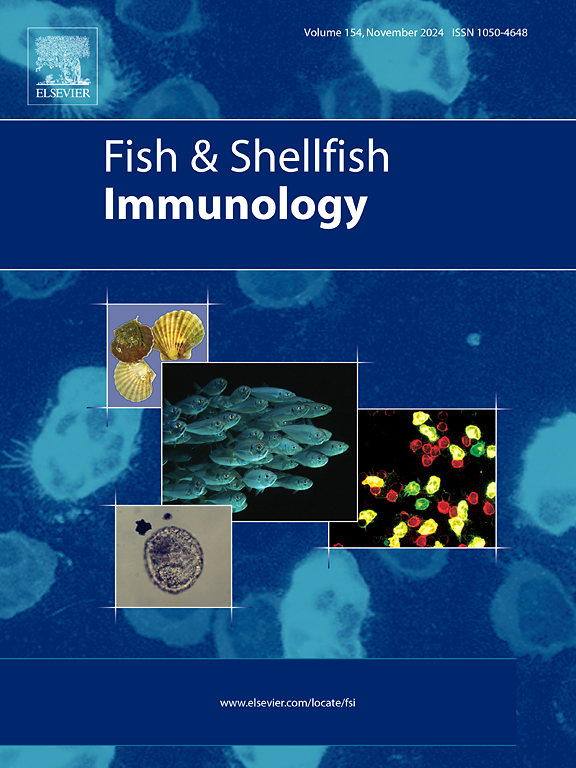桑叶黄酮酶水解物的制备及其治疗斑马鱼炎症性肠病的机制研究
IF 4.1
2区 农林科学
Q1 FISHERIES
引用次数: 0
摘要
简介:近年来,炎症性肠病(IBD)的发病率逐年上升:近年来,炎症性肠病(IBD)的发病率逐年上升。黄酮类化合物是桑叶的主要成分,具有抗炎作用,有望应用于治疗 IBD 的药物筛选。酶水解可提高黄酮苷的生物利用度和活性。目前尚未检索到桑叶黄酮类化合物(MLF)经脱糖后增效的相关报道:方法:采用酶法制备桑叶黄酮(MLF)的酶水解物(EMLF)。通过观察斑马鱼肠道的长度和宽度、肠道组织病理学形态以及中性粒细胞和嗜酸性粒细胞的表达,评估EMLF对IBD斑马鱼的保护作用。通过网络药理学和代谢组学研究,探讨了EMLF对IBD的作用机制。最后,利用Western Blot和实时定量聚合酶链反应(RT-qPCR)验证了EMLF对IBD的作用机制:结果:首次利用蜗牛酶水解MLF成功制备了EMLF,并明确了EMLF对IBD斑马鱼的抗炎作用优于MLF。网络药理学和代谢组学研究表明,EMLF治疗IBD的机制可能与嘌呤代谢途径的调控有关。与TNBS组相比,嘌呤代谢的关键靶点腺苷脱氨酶(ADA)的表达水平显著下调,而腺嘌呤磷酸核糖转移酶(APRT)和黄嘌呤脱氢酶(XDH)的表达水平显著升高:结果表明,酶法脱糖是提高MLF抗炎活性的有效措施,为天然药物资源的深加工和利用提供了可借鉴的思路和方法。本文章由计算机程序翻译,如有差异,请以英文原文为准。
Preparation of enzymatic hydrolysates of mulberry leaf flavonoids and investigation into its treatment and mechanism for zebrafish inflammatory bowel disease
Introduction
The incidence of inflammatory bowel disease (IBD) has been increasing year by year in recent years. Flavonoids are the main components of mulberry leaves exerting anti-inflammatory effects and have potential applications in drug screening for IBD treatment. Enzymatic hydrolysis can enhance the bioavailability and activity of flavonoid glycosides. No relevant reports on the potentiation of mulberry leaf flavonoids (MLF) after deglycosylation have been retrieved.
Methods
An enzymatic method was used to prepare enzymatic hydrolysates of MLF (EMLF). The protective effect of EMLF on zebrafish with IBD was evaluated by observing zebrafish intestinal length and width, intestinal histopathological morphology, as well as neutrophil and goblet expression. Network pharmacology and metabolomics were performed to explore the mechanism of action of EMLF against IBD. Finally, the mechanism of EMLF against IBD was validated using Western Blot and real-time quantitative polymerase chain reaction (RT-qPCR).
Results
The EMLF was successfully prepared by hydrolyzing MLF with snailase for the first time, and the anti-inflammatory effect of EMLF was clarified to be superior to that of MLF in IBD zebrafish. The network pharmacology and metabolomics studies showed that the mechanism of EMLF for IBD may be related to regulation of purine metabolic pathway. The expression levels of adenosine deaminase (ADA), critical targets in purine metabolism, were significantly down-regulated, while the expression of adenine phosphoribosyltransferase (APRT) and xanthine dehydrogenase (XDH) was significantly increased when compared with the TNBS group.
Conclusion
The results suggested that enzymatic deglycosylation is an effective measure to enhance the anti-inflammatory activity of MLF, which provides referable ideas and methods for the deep processing and utilization of natural drug resources.
求助全文
通过发布文献求助,成功后即可免费获取论文全文。
去求助
来源期刊

Fish & shellfish immunology
农林科学-海洋与淡水生物学
CiteScore
7.50
自引率
19.10%
发文量
750
审稿时长
68 days
期刊介绍:
Fish and Shellfish Immunology rapidly publishes high-quality, peer-refereed contributions in the expanding fields of fish and shellfish immunology. It presents studies on the basic mechanisms of both the specific and non-specific defense systems, the cells, tissues, and humoral factors involved, their dependence on environmental and intrinsic factors, response to pathogens, response to vaccination, and applied studies on the development of specific vaccines for use in the aquaculture industry.
 求助内容:
求助内容: 应助结果提醒方式:
应助结果提醒方式:


